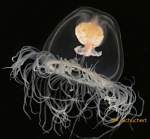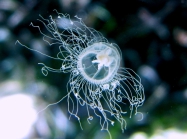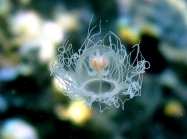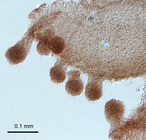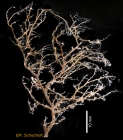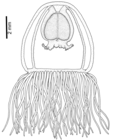WoRMS taxon details
Oceania armata Kölliker, 1853
117437 (urn:lsid:marinespecies.org:taxname:117437)
accepted
Species
Callitiara polyophtalma Haeckel, 1879 · unaccepted (synonym)
Conis cyclophthalma Haeckel, 1879 · unaccepted (synonym)
Corydendrium chevalense Thornely, 1904 · unaccepted (basionym)
Oceania tydemani Bleeker & van der Spoel, 1988 · unaccepted (synonym)
Tiarella parthenopia Trinci, 1906 · unaccepted (synonym)
Turritopsis armata (Kölliker, 1853) · unaccepted
Turritopsis chevalense (Thorneley, 1904) · unaccepted (possible synonym)
Turritopsis fascicularis Fraser, 1943 · unaccepted (synonym)
marine, fresh, terrestrial
recent only
Kölliker, A., 1853. Bericht über einige im Herbste 1852 in Messina angestellte vergleichend-anatomische Untersuchungen. In: Gegenbaur, Kölliker & Müller, 1853. Z. wiss. Zool. 4 3-4: 298-370., available online at https://www.biodiversitylibrary.org/page/14275422
page(s): 323 [details]
page(s): 323 [details]
Type locality contained in Messina Strait
, Note Strait of Messina, Mediterranean
type locality contained in Messina Strait [details]
From editor or global species database
Type locality Strait of Messina, Mediterranean [details]
Description
Mature medusa 5-10 mm high, maximal bell diameter about the same as height, umbrella bell-shaped with flat top, jelly...
Distribution
The medusa occurs in coastal waters of tropical to warm temperate seas. It has been recorded from the Mediterranean,...
Mature medusa 5-10 mm high, maximal bell diameter about the same as height, umbrella bell-shaped with flat top, jelly...
Description
Mature medusa 5-10 mm high, maximal bell diameter about the same as height, umbrella bell-shaped with flat top, jelly uniformly thin. Manubrium on a transparent, shallow peduncle, not encircled by blocks of vacuolated cells but vacuolated cells present along proximal parts of radial canals. Manubrium large, up to 2/3 of subumbrellar height, ovoid, manubrium base constricted, with funnel-shaped mouth region. Stomach and mouth region distinctly cruciform in cross-section. Radial canals where joining manubrium funnel-like dilated and composed of large, vacuolated cells, continued on manubrium as perradial ribs resembling four clasping claws. Mouth rim in folds, with four prominent perradial lips. Margin of mouth with a continuous row of spherical nematocyst clusters, these usually on a short pedicel. Gonads smooth, on interradial surface of stomach. Four quite broad radial canals, margins occasionally jagged, circular canal broad. Marginal tentacles 80-120, evenly tapering, gastrodermis chordoid. Origins of tentacles somewhat alternately displaced adaxially and abaxially (= in 2 rows). Each tentacle with a slight proximal swelling beginning shortly after origin. Adaxial ocelli near tentacle base. Nematocysts: microbasic euryteles, desmonemes. Colours: manubrium and gonads yellow, orange or orange brown, ocelli brown-red. Egg size about 0.27 mm.
Polyp stage forming erect, branched colonies, 1-10 cm, strongly polysiphonic, thinning out to monosiphonic. Proximal parts of monosiphonic side-branches and hydranth pedicels adnate to branch of origin. Hydranths at ends of side branches, tubular, 0.6-1 mm high, with rounded hypostome, up to 18 scattered filiform tentacles. Medusa buds at end of thin side-branches with proximal region adnate, spherical, 0.4-0.5 mm, in advanced stages with four broad radial canals, manubrium very short, with four interradial pads, four marginal bulbs, about 8 tentacles stubs. Nematocysts of polyps are microbasic euryteles and desmonemes.
[details]
Mature medusa 5-10 mm high, maximal bell diameter about the same as height, umbrella bell-shaped with flat top, jelly uniformly thin. Manubrium on a transparent, shallow peduncle, not encircled by blocks of vacuolated cells but vacuolated cells present along proximal parts of radial canals. Manubrium large, up to 2/3 of subumbrellar height, ovoid, manubrium base constricted, with funnel-shaped mouth region. Stomach and mouth region distinctly cruciform in cross-section. Radial canals where joining manubrium funnel-like dilated and composed of large, vacuolated cells, continued on manubrium as perradial ribs resembling four clasping claws. Mouth rim in folds, with four prominent perradial lips. Margin of mouth with a continuous row of spherical nematocyst clusters, these usually on a short pedicel. Gonads smooth, on interradial surface of stomach. Four quite broad radial canals, margins occasionally jagged, circular canal broad. Marginal tentacles 80-120, evenly tapering, gastrodermis chordoid. Origins of tentacles somewhat alternately displaced adaxially and abaxially (= in 2 rows). Each tentacle with a slight proximal swelling beginning shortly after origin. Adaxial ocelli near tentacle base. Nematocysts: microbasic euryteles, desmonemes. Colours: manubrium and gonads yellow, orange or orange brown, ocelli brown-red. Egg size about 0.27 mm.
Polyp stage forming erect, branched colonies, 1-10 cm, strongly polysiphonic, thinning out to monosiphonic. Proximal parts of monosiphonic side-branches and hydranth pedicels adnate to branch of origin. Hydranths at ends of side branches, tubular, 0.6-1 mm high, with rounded hypostome, up to 18 scattered filiform tentacles. Medusa buds at end of thin side-branches with proximal region adnate, spherical, 0.4-0.5 mm, in advanced stages with four broad radial canals, manubrium very short, with four interradial pads, four marginal bulbs, about 8 tentacles stubs. Nematocysts of polyps are microbasic euryteles and desmonemes.
[details]
Distribution
The medusa occurs in coastal waters of tropical to warm temperate seas. It has been recorded from the Mediterranean,...
Distribution
The medusa occurs in coastal waters of tropical to warm temperate seas. It has been recorded from the Mediterranean, coasts of Senegal and Gambia, Canary Islands, Cape Verde, Azores, Portugal, West Indies, Japan, New Zealand, Tasman Sea, South China Sea, Red Sea; apparently it is absent from the eastern Pacific Ocean. The medusa occurs usually in depths of less than 200 m, but not at the surface. [details]
The medusa occurs in coastal waters of tropical to warm temperate seas. It has been recorded from the Mediterranean, coasts of Senegal and Gambia, Canary Islands, Cape Verde, Azores, Portugal, West Indies, Japan, New Zealand, Tasman Sea, South China Sea, Red Sea; apparently it is absent from the eastern Pacific Ocean. The medusa occurs usually in depths of less than 200 m, but not at the surface. [details]
Schuchert, P.; Choong, H.; Galea, H.; Hoeksema, B.; Lindsay, D.; Manko, M.; Pica, D. (2025). World Hydrozoa Database. Oceania armata Kölliker, 1853. Accessed through: World Register of Marine Species at: https://www.marinespecies.org/aphia.php?p=taxdetails&id=117437 on 2025-04-06
Date
action
by
![]() The webpage text is licensed under a Creative Commons
Attribution 4.0 License
The webpage text is licensed under a Creative Commons
Attribution 4.0 License
Nomenclature
original description
Kölliker, A., 1853. Bericht über einige im Herbste 1852 in Messina angestellte vergleichend-anatomische Untersuchungen. In: Gegenbaur, Kölliker & Müller, 1853. Z. wiss. Zool. 4 3-4: 298-370., available online at https://www.biodiversitylibrary.org/page/14275422
page(s): 323 [details]
original description (of Oceania tydemani Bleeker & van der Spoel, 1988) Bleeker, J. & S. van der Spoel, 1988. Medusae of the Amsterdam Mid North Atlantic Plankton Expeditions (1980-1983) with descriptions of two new species. Bijdr. Dierk. 58 2: 227-258.
page(s): 249 [details]
original description (of Turritopsis fascicularis Fraser, 1943) Fraser, C. M. (1943). Distribution records of some hydroids in the collection of the Museum of Comparative Zoölogy at Harvard College, with description of new genera and new species. <em>Proceedings of the New England Zoölogical Club.</em> 22: 75-98, pls 15-20.
page(s): 76, pl. 15 fig. 1 [details] Available for editors [request]
[request]
original description (of Callitiara polyophtalma Haeckel, 1879) Haeckel, E. (1879). Das System der Medusen. Erster Teil einer Monographie der Medusen. <em>Denkschriften der Medicinisch-Naturwissenschaftlichen Gesellschaft zu Jena.</em> 1: XX+1-360, 320 plates., available online at https://www.biodiversitylibrary.org/page/32605578
page(s): 67, pl. 3 figs 1-5. [details]
original description (of Conis cyclophthalma Haeckel, 1879) Haeckel, E. (1879). Das System der Medusen. Erster Teil einer Monographie der Medusen. <em>Denkschriften der Medicinisch-Naturwissenschaftlichen Gesellschaft zu Jena.</em> 1: XX+1-360, 320 plates., available online at https://www.biodiversitylibrary.org/page/32605578
page(s): 55, pl. 4 fig. 1. [details]
original description (of Tiarella parthenopia Trinci, 1906) Trinci, G., 1906. Tiarella parthenopea, nuovo genere e specie della famiglia Tiaridae. Monitore zool. ital. 17 : 208-213., available online at http://archive.org/stream/monitorezoologic17runi#page/208/mode/2up
page(s): 208 [details]
original description (of Corydendrium chevalense Thornely, 1904) Thornely, L. A. 1904. Report on the Hydroida collected by professor Herdman, at Ceylon, in 1902. - Report to the Government of Ceylon on the pearl oyster fisheries of the Gulf of Manaar 2, no. suppl. Rep. 8: 107-126., available online at https://www.biodiversitylibrary.org/page/1943078
page(s): 109, pl. 1 fig. 4 [details]
basis of record van der Land, J.; Vervoort, W.; Cairns, S.D.; Schuchert, P. (2001). Hydrozoa, <B><I>in</I></B>: Costello, M.J. <i>et al.</i> (Ed.) (2001). <i>European register of marine species: a check-list of the marine species in Europe and a bibliography of guides to their identification. Collection Patrimoines Naturels,</i> 50: pp. 112-120 (look up in IMIS) [details]
page(s): 323 [details]
original description (of Oceania tydemani Bleeker & van der Spoel, 1988) Bleeker, J. & S. van der Spoel, 1988. Medusae of the Amsterdam Mid North Atlantic Plankton Expeditions (1980-1983) with descriptions of two new species. Bijdr. Dierk. 58 2: 227-258.
page(s): 249 [details]
original description (of Turritopsis fascicularis Fraser, 1943) Fraser, C. M. (1943). Distribution records of some hydroids in the collection of the Museum of Comparative Zoölogy at Harvard College, with description of new genera and new species. <em>Proceedings of the New England Zoölogical Club.</em> 22: 75-98, pls 15-20.
page(s): 76, pl. 15 fig. 1 [details] Available for editors
original description (of Callitiara polyophtalma Haeckel, 1879) Haeckel, E. (1879). Das System der Medusen. Erster Teil einer Monographie der Medusen. <em>Denkschriften der Medicinisch-Naturwissenschaftlichen Gesellschaft zu Jena.</em> 1: XX+1-360, 320 plates., available online at https://www.biodiversitylibrary.org/page/32605578
page(s): 67, pl. 3 figs 1-5. [details]
original description (of Conis cyclophthalma Haeckel, 1879) Haeckel, E. (1879). Das System der Medusen. Erster Teil einer Monographie der Medusen. <em>Denkschriften der Medicinisch-Naturwissenschaftlichen Gesellschaft zu Jena.</em> 1: XX+1-360, 320 plates., available online at https://www.biodiversitylibrary.org/page/32605578
page(s): 55, pl. 4 fig. 1. [details]
original description (of Tiarella parthenopia Trinci, 1906) Trinci, G., 1906. Tiarella parthenopea, nuovo genere e specie della famiglia Tiaridae. Monitore zool. ital. 17 : 208-213., available online at http://archive.org/stream/monitorezoologic17runi#page/208/mode/2up
page(s): 208 [details]
original description (of Corydendrium chevalense Thornely, 1904) Thornely, L. A. 1904. Report on the Hydroida collected by professor Herdman, at Ceylon, in 1902. - Report to the Government of Ceylon on the pearl oyster fisheries of the Gulf of Manaar 2, no. suppl. Rep. 8: 107-126., available online at https://www.biodiversitylibrary.org/page/1943078
page(s): 109, pl. 1 fig. 4 [details]
basis of record van der Land, J.; Vervoort, W.; Cairns, S.D.; Schuchert, P. (2001). Hydrozoa, <B><I>in</I></B>: Costello, M.J. <i>et al.</i> (Ed.) (2001). <i>European register of marine species: a check-list of the marine species in Europe and a bibliography of guides to their identification. Collection Patrimoines Naturels,</i> 50: pp. 112-120 (look up in IMIS) [details]
Taxonomy
redescription
Schuchert, P. (2016). The polyps of Oceania armata identified by DNA barcoding (Cnidaria, Hydrozoa). <em>Zootaxa.</em> 4175(6): 539-550., available online at https://doi.org/10.11646/zootaxa.4175.6.3
page(s): 539, figs 1-3 [details] Available for editors [request]
[request]
redescription Schuchert, P. (2004). Revision of the European athecate hydroids and their medusae (Hydrozoa, Cnidaria): families Oceanidae and Pachycordylidae. <em>Revue Suisse de Zoologie.</em> 111 2: 315-369.
page(s): 333 [details]
status source Miglietta, M. P.; Maggioni, D.; Matsumoto, Y. (2018). Phylogenetics and species delimitation of two hydrozoa (phylum Cnidaria): Turritopsis (McCrady, 1857) and Pennaria (Goldfuss, 1820). <em>Marine Biodiversity.</em> 49(3): 1085-1100., available online at https://doi.org/10.1007/s12526-018-0891-8 [details]
page(s): 539, figs 1-3 [details] Available for editors
redescription Schuchert, P. (2004). Revision of the European athecate hydroids and their medusae (Hydrozoa, Cnidaria): families Oceanidae and Pachycordylidae. <em>Revue Suisse de Zoologie.</em> 111 2: 315-369.
page(s): 333 [details]
status source Miglietta, M. P.; Maggioni, D.; Matsumoto, Y. (2018). Phylogenetics and species delimitation of two hydrozoa (phylum Cnidaria): Turritopsis (McCrady, 1857) and Pennaria (Goldfuss, 1820). <em>Marine Biodiversity.</em> 49(3): 1085-1100., available online at https://doi.org/10.1007/s12526-018-0891-8 [details]
Other
context source (Hexacorallia)
Fautin, Daphne G. (2013). Hexacorallians of the World. (look up in IMIS) [details]
additional source Navas-Pereira, D. & Vannucci, M. (1991). The Hydromedusae and water masses of the Indian Ocean. <em>Bolm Inst. Oceanogr.</em> 39(1): 25-60. [details]
additional source Schuchert P. (1996). The marine fauna of New Zealand: Athecate hydroids and their medusae (Cnidaria: Hydrozoa). <em>New Zealand Oceanographic Institute Memoir.</em> 106 : 1-159., available online at https://archive.org/details/nzoimemoir01061996/mode/2up
page(s): 15-16, 158 [details]
additional source Segura-Puertas, L., L. Celis, and L. Chiaverano. 2009. Medusozoans (Cnidaria: Cubozoa, Scyphozoa, and Hydrozoa) of the Gulf of Mexico, Pp. 369–379 in Felder, D.L. and D.K. Camp (eds.), Gulf of Mexico–Origins, Waters, and Biota. Biodiversity. Texas A&M Pre [details]
additional source Liu, J.Y. [Ruiyu] (ed.). (2008). Checklist of marine biota of China seas. <em>China Science Press.</em> 1267 pp. (look up in IMIS) [details] Available for editors [request]
[request]
additional source Cairns, S.D., L. Gershwin, F.J. Brook, P. Pugh, E.W. Dawson, O.V. Ocaña, W. Vervoort, G. Williams, J.E. Watson, D.M. Opresko, P. Schuchert, P.M. Hine, D.P. Gordon, H.I. Campbell, A.J. Wright, J.A.Sánchez & D.G. Fautin. (2009). Phylum Cnidaria: corals, medusae, hydroids, myxozoans. <em>in: Gordon, D.P. (Ed.) (2009). New Zealand inventory of biodiversity: 1. Kingdom Animalia: Radiata, Lophotrochozoa, Deuterostomia.</em> :59-101., available online at https://repository.si.edu/handle/10088/8431 [details] Available for editors [request]
[request]
additional source Navas-Pereira, D. & Vannucci, M. (1991). The Hydromedusae and water masses of the Indian Ocean. <em>Bolm Inst. Oceanogr.</em> 39(1): 25-60. [details]
additional source Schuchert P. (1996). The marine fauna of New Zealand: Athecate hydroids and their medusae (Cnidaria: Hydrozoa). <em>New Zealand Oceanographic Institute Memoir.</em> 106 : 1-159., available online at https://archive.org/details/nzoimemoir01061996/mode/2up
page(s): 15-16, 158 [details]
additional source Segura-Puertas, L., L. Celis, and L. Chiaverano. 2009. Medusozoans (Cnidaria: Cubozoa, Scyphozoa, and Hydrozoa) of the Gulf of Mexico, Pp. 369–379 in Felder, D.L. and D.K. Camp (eds.), Gulf of Mexico–Origins, Waters, and Biota. Biodiversity. Texas A&M Pre [details]
additional source Liu, J.Y. [Ruiyu] (ed.). (2008). Checklist of marine biota of China seas. <em>China Science Press.</em> 1267 pp. (look up in IMIS) [details] Available for editors
additional source Cairns, S.D., L. Gershwin, F.J. Brook, P. Pugh, E.W. Dawson, O.V. Ocaña, W. Vervoort, G. Williams, J.E. Watson, D.M. Opresko, P. Schuchert, P.M. Hine, D.P. Gordon, H.I. Campbell, A.J. Wright, J.A.Sánchez & D.G. Fautin. (2009). Phylum Cnidaria: corals, medusae, hydroids, myxozoans. <em>in: Gordon, D.P. (Ed.) (2009). New Zealand inventory of biodiversity: 1. Kingdom Animalia: Radiata, Lophotrochozoa, Deuterostomia.</em> :59-101., available online at https://repository.si.edu/handle/10088/8431 [details] Available for editors
 Present
Present  Present in aphia/obis/gbif/idigbio
Present in aphia/obis/gbif/idigbio  Inaccurate
Inaccurate  Introduced: alien
Introduced: alien  Containing type locality
Containing type locality
From editor or global species database
Biology colonial hydroid, free medusa [details]Description
Mature medusa 5-10 mm high, maximal bell diameter about the same as height, umbrella bell-shaped with flat top, jelly uniformly thin. Manubrium on a transparent, shallow peduncle, not encircled by blocks of vacuolated cells but vacuolated cells present along proximal parts of radial canals. Manubrium large, up to 2/3 of subumbrellar height, ovoid, manubrium base constricted, with funnel-shaped mouth region. Stomach and mouth region distinctly cruciform in cross-section. Radial canals where joining manubrium funnel-like dilated and composed of large, vacuolated cells, continued on manubrium as perradial ribs resembling four clasping claws. Mouth rim in folds, with four prominent perradial lips. Margin of mouth with a continuous row of spherical nematocyst clusters, these usually on a short pedicel. Gonads smooth, on interradial surface of stomach. Four quite broad radial canals, margins occasionally jagged, circular canal broad. Marginal tentacles 80-120, evenly tapering, gastrodermis chordoid. Origins of tentacles somewhat alternately displaced adaxially and abaxially (= in 2 rows). Each tentacle with a slight proximal swelling beginning shortly after origin. Adaxial ocelli near tentacle base. Nematocysts: microbasic euryteles, desmonemes. Colours: manubrium and gonads yellow, orange or orange brown, ocelli brown-red. Egg size about 0.27 mm.
Polyp stage forming erect, branched colonies, 1-10 cm, strongly polysiphonic, thinning out to monosiphonic. Proximal parts of monosiphonic side-branches and hydranth pedicels adnate to branch of origin. Hydranths at ends of side branches, tubular, 0.6-1 mm high, with rounded hypostome, up to 18 scattered filiform tentacles. Medusa buds at end of thin side-branches with proximal region adnate, spherical, 0.4-0.5 mm, in advanced stages with four broad radial canals, manubrium very short, with four interradial pads, four marginal bulbs, about 8 tentacles stubs. Nematocysts of polyps are microbasic euryteles and desmonemes.
[details]
Distribution
The medusa occurs in coastal waters of tropical to warm temperate seas. It has been recorded from the Mediterranean, coasts of Senegal and Gambia, Canary Islands, Cape Verde, Azores, Portugal, West Indies, Japan, New Zealand, Tasman Sea, South China Sea, Red Sea; apparently it is absent from the eastern Pacific Ocean. The medusa occurs usually in depths of less than 200 m, but not at the surface. [details]
Type locality Strait of Messina, Mediterranean [details]
| Language | Name | |
|---|---|---|
| Japanese | ベニクラゲモドキ | [details] |
To Barcode of Life (2 barcodes) (from synonym Turritopsis chevalense (Thorneley, 1904))
To Barcode of Life (6 barcodes)
To Biodiversity Heritage Library (2 publications) (from synonym Oceania tydemani Bleeker & van der Spoel, 1988)
To Biodiversity Heritage Library (2 publications) (from synonym Turritopsis chevalense (Thorneley, 1904))
To Biodiversity Heritage Library (3 publications) (from synonym Turritopsis fascicularis Fraser, 1943)
To Biodiversity Heritage Library (34 publications)
To Biological Information System for Marine Life (BISMaL)
To European Nucleotide Archive, ENA (Oceania armata)
To European Nucleotide Archive, ENA (Turritopsis chevalense) (from synonym Turritopsis chevalense (Thorneley, 1904))
To GenBank (13 nucleotides; 6 proteins) (from synonym Turritopsis fascicularis Fraser, 1943)
To GenBank (13 nucleotides; 6 proteins)
To GenBank (3 nucleotides; 2 proteins) (from synonym Corydendrium chevalense Thornely, 1904)
To GenBank (3 nucleotides; 2 proteins) (from synonym Turritopsis chevalense (Thorneley, 1904))
To PESI
To USNM Invertebrate Zoology Cnidaria Collection (2 records)
To USNM Invertebrate Zoology Cnidaria Collection (2 records) (from synonym Turritopsis fascicularis Fraser, 1943)
To ITIS
To Barcode of Life (6 barcodes)
To Biodiversity Heritage Library (2 publications) (from synonym Oceania tydemani Bleeker & van der Spoel, 1988)
To Biodiversity Heritage Library (2 publications) (from synonym Turritopsis chevalense (Thorneley, 1904))
To Biodiversity Heritage Library (3 publications) (from synonym Turritopsis fascicularis Fraser, 1943)
To Biodiversity Heritage Library (34 publications)
To Biological Information System for Marine Life (BISMaL)
To European Nucleotide Archive, ENA (Oceania armata)
To European Nucleotide Archive, ENA (Turritopsis chevalense) (from synonym Turritopsis chevalense (Thorneley, 1904))
To GenBank (13 nucleotides; 6 proteins) (from synonym Turritopsis fascicularis Fraser, 1943)
To GenBank (13 nucleotides; 6 proteins)
To GenBank (3 nucleotides; 2 proteins) (from synonym Corydendrium chevalense Thornely, 1904)
To GenBank (3 nucleotides; 2 proteins) (from synonym Turritopsis chevalense (Thorneley, 1904))
To PESI
To USNM Invertebrate Zoology Cnidaria Collection (2 records)
To USNM Invertebrate Zoology Cnidaria Collection (2 records) (from synonym Turritopsis fascicularis Fraser, 1943)
To ITIS
